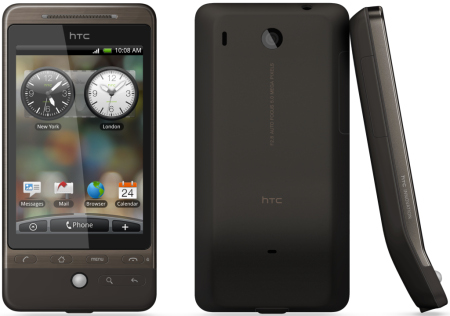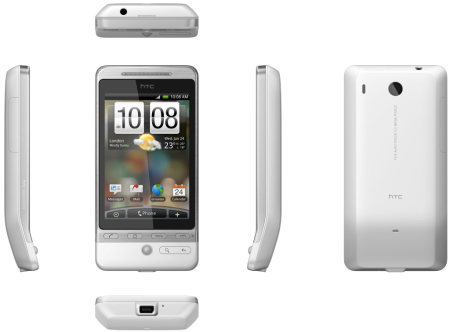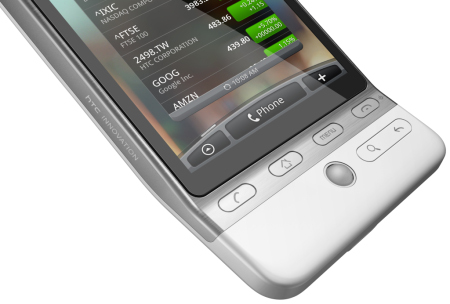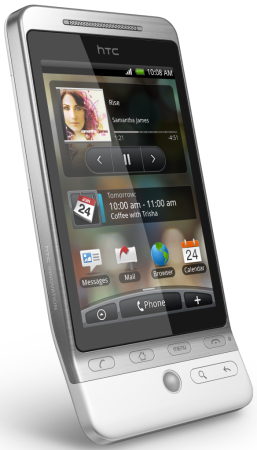Android phone boasts customizable UI
Jun 24, 2009 — by Eric Brown — from the LinuxDevices Archive — 4 views HTC has announced its third Android-driven smartphone, debuting an HTC-designed customizable user interface (UI). The HTC Hero adds new styling, Adobe Flash support, and a five megapixel camera to the similar HTC Magic and MyTouch 3G designs, and introduces a new UI layer called HTC Sense.
HTC has announced its third Android-driven smartphone, debuting an HTC-designed customizable user interface (UI). The HTC Hero adds new styling, Adobe Flash support, and a five megapixel camera to the similar HTC Magic and MyTouch 3G designs, and introduces a new UI layer called HTC Sense.
The Hero will be made available across Europe in July, with Orange announcing it will offer the phone in the U.K., and a BBC report claiming that T-Mobile will offer the phone in Europe under a different brand name. The phone will also be offered in Asia later in the summer, with a similar North American model showing up in the fall, says HTC.

HTC Hero in graphite
(Click to enlarge)
According to Adobe, meanwhile, the Hero will be the first Android smartphone to offer its Flash media playback technology. A video demo of the Hero running Flash may be found on this Adobe page, showing Flash video and games, including the ability to double-click a Flash movie to bring it to full screen. The Hero's Flash playback capability is apparently not the same as the "full desktop" Flash 10 version scheduled to arrive this fall on mobile devices, however.
Magic with a beveled twist
In basic hardware specs, the Hero is similar to the original Android phone, the T-Mobile-sold HTC G1 introduced last October. It is even more closely imitative of the HTC Magic launched by Vodafone this spring, and the new, Magic-like, HTC-built MyTouch 3G announced this week by T-Mobile.

Hero from all sides
(Click to enlarge)
The Hero offers the same 3.2-inch, QVGA (320×480) TFT-LCD touchscreen as the earlier models. It again provides HSDPA/WCDMA 3G for downlinks of up to 7.2Mbps, as well as quad-band 2G GSM/GPRS/EDGE network support. Additional features are also similar, including 802.11/b/g WiFi, Bluetooth 2.0, GPS, accelerometer, and digital compass. The only major hardware enhancement appears to be the five megapixel camera, up from 3.2 megapixels for the Magic.
The Teflon Android phone
Like the Magic models, the Hero lacks the G1's slide-out keyboard and instead depends on Android 1.5's virtual touchscreen keyboard. Accordingly, the 4.4 x 2.2 x 0.6-inch dimensions are about the same as the slimmed-down Magic models, although the Hero weighs a bit more at about 4.8 ounces. Claimed talk and standby times are slightly higher than with the Magic, for example, offering a claimed 420 minutes on WCDMA, 20 minutes more than the Magic.

The Hero up close
(Click to enlarge)
Specifications listed for the Hero are said to include:
- Processor — Qualcomm MSM7200A, 528MHz
- Memory — 288MB RAM
- Flash — 512MB ROM
- Flash expansion — 1 x microSD memory card for up to 16GB (SD 2.0 compatible)
- Display — 3.2-inch TFT-LCD touch-sensitive screen with 320×480 HVGA
- Cellular HSPA/WCDMA — 900/2100 MHz with up to 2Mbps uplink and 7.2Mbps downlink
- Cellular quad-band GSM/GPRS/EDGE — 850/900/1800/1900MHz
- WiFi — 802.11 b/g
- Bluetooth — Bluetooth 2.0 with EDR and A2DP
- GPS — internal GPS antenna
- Camera — Five megapixel color camera with autofocus
- Other features:
- G-sensor (accelerometers)
- Digital compass
- 3.5mm audio jack
- Trackball with Enter button
- Audio formats — MP3, AAC(AAC, AAC+, AAC-LC), AMR-NB, WAV, MID, Windows Media Audio 9
- Video formats — MPEG-4, H.263, H.264, Windows Media Video 9
- Battery — Rechargeable Lithium-ion 1350mAh
- Talk time — Up to 420 minutes for WCDMA; up to 470 minutes for GSM
- Standby time — Up to 750 hours for WCDMA; up to 440 hours for GSM
- AC adapter — Voltage range/frequency — 100 ~ 240V AC, 50/60Hz; DC output 5V and 1A
- Dimensions — 4.4 x 2.2 x 0.6 inches (112 x 56.2 x 14.35mm)
- Weight — 4.8 oz (135 g)
- Operating system — Android (Linux/Java)
HTC Sense and the debut of Android customization
HTC has yet to offer extensive details on its new HTC Sense UI, which is claimed to offer greater customization and improved integration of communications. Customization features are said to include the ability to add "glance view" widgets that push content like Twitter feeds, weather, and other content to the surface, or tailor the UI for quick access to business-focused information like email, calendar and world-times. A new profile feature called "scenes" lets users create different customized content profiles around specific functions or time periods, says the company.

Hero in Teflon-coated white
(Click to enlarge)
Additional features of HTC Sense include an enhanced smart dialer, and the ability to turn the phone over to silence a ring. There is also a "perspectives" feature that is said to offer different ways to view content such as email, photos, Twitter, and music.
Together with the separate T-Mobile-developed interface for the MyTouch 3G, HTC Sense represents the realization of Google's plan to encourage spin-offs of the open source Android stack, with customized UIs and branding experiences offered by different carriers and manufacturers.
This open source customization advantage is also touted by the LiMo Foundation on phones running its LiMo (Linux Mobile) spec. It remains to be seen to what degree the third major Linux mobile smartphone stack provider, Palm, will embrace the customization strategy with the Pre and its WebOS, although the company has made a good start by posting open source code on its OpenSource Palm site, here.
Stated Peter Chou, CEO, HTC Corp., "HTC Sense is a distinct experience created to make HTC phones more simple for people to use, leaving them saying, it just makes sense."
A video demo of the HTC Hero
Source: Orange
(click to play)
Availability
The HTC Hero will be available across Europe in July, and in Asia later in the summer, says HTC. A "distinct" North American version will be available later in 2009, says the company.
In the U.K, Orange says it is offering the graphite-colored version of the HTC Hero for free to customers who take out a two-year, 39.15 Pounds (about $65 US) per month contract. The package includes 1,200 any-network call minutes, as well as unlimited texts and web browsing, says the wireless carrier.
More information on the Orange version of the Hero may be found here.
This article was originally published on LinuxDevices.com and has been donated to the open source community by QuinStreet Inc. Please visit LinuxToday.com for up-to-date news and articles about Linux and open source.